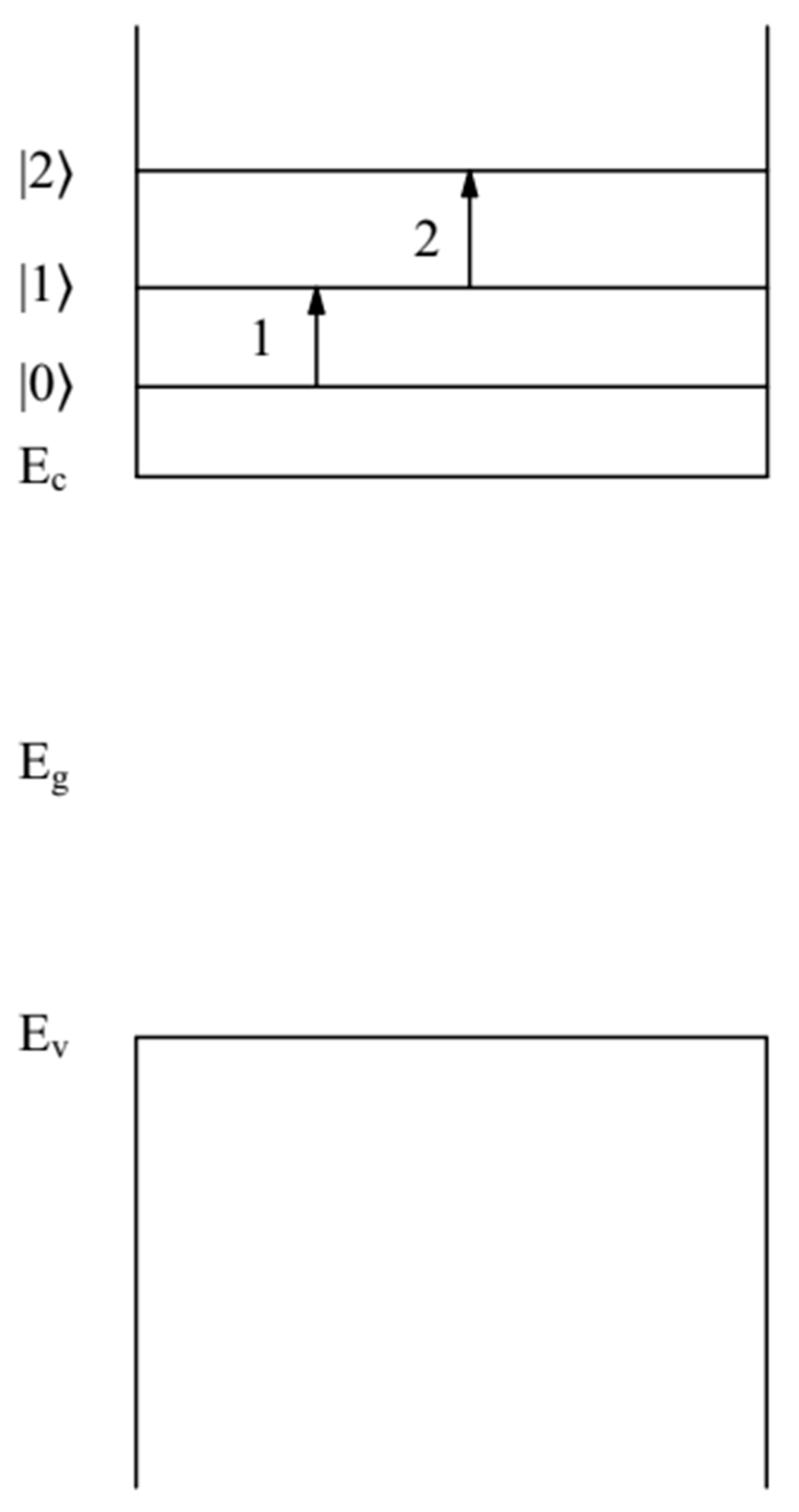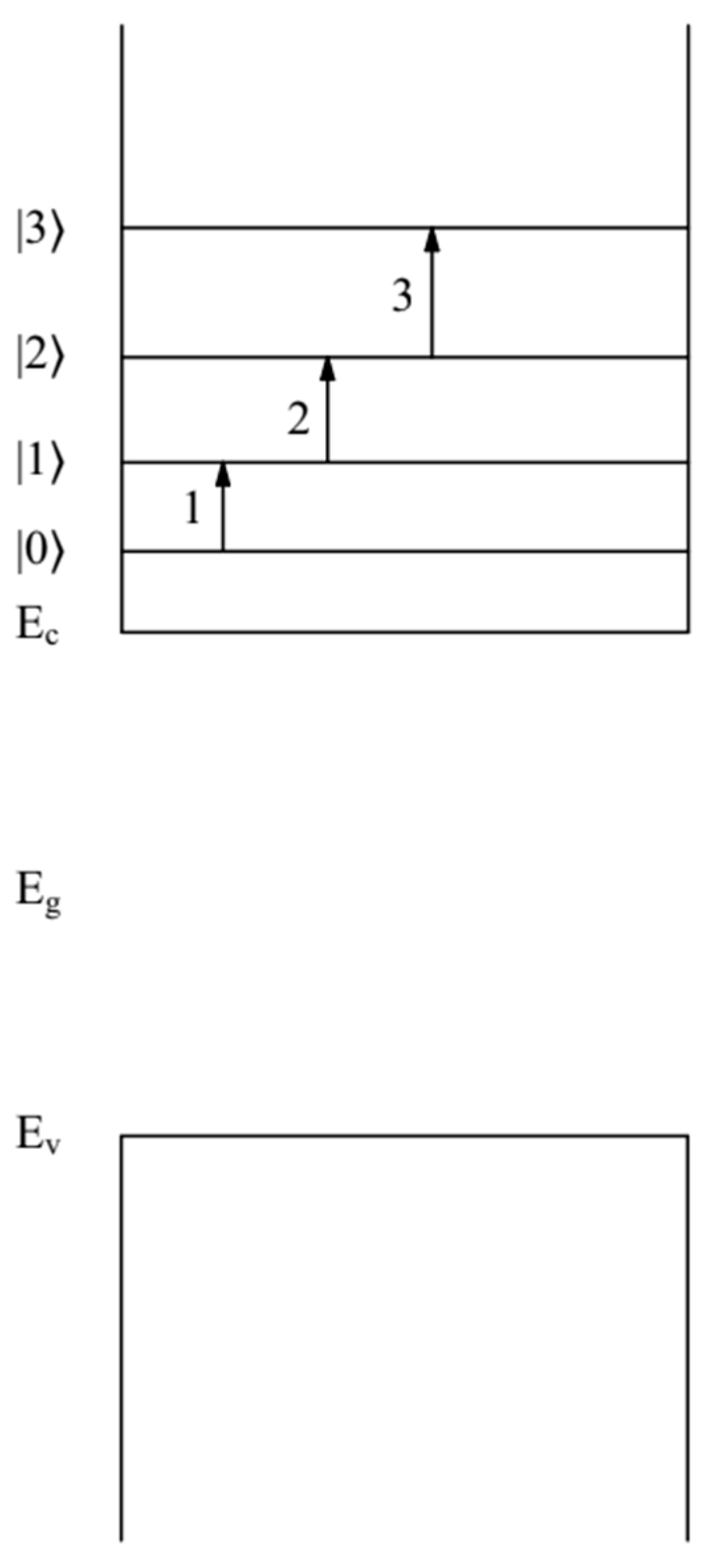Optical Absorption on Electron Quantum-Confined States of Perovskite Quantum Dots
Abstract
:1. Introduction
2. Theoretical Method and Model
2.1. Quantum-Confined Electron States in a Nanosystem
2.2. Dipole Moments of Transitions in a Nanosystem
2.3. Intensity of Optical Transitions in the Nanosystem
2.4. Optical Absorption on Quantum-Confined Electron States in a Nanosystem
3. Numerical Results and Discussion
4. Conclusions
Author Contributions
Funding
Data Availability Statement
Conflicts of Interest
References
- Ye, Z.; Cao, T.; O’Brien, K.; Zhu, H.; Yin, X.; Wang, Y.; Louie, S.G.; Zhang, X. Probing excitonic dark states in single-layer tungsten disulphide. Nature 2014, 513, 214. [Google Scholar] [CrossRef] [PubMed]
- Ye, Y.; Wong, Z.J.; Lu, X.; Ni, X.; Zhu, H.; Chen, X.; Wang, Y.; Zhang, X. Monolayer excitonic laser. Nat. Photon. 2015, 9, 733. [Google Scholar] [CrossRef]
- Blancon, J.-C.; Tsai, H.; Nie, W.; Stoumpos, C.C.; Pedesseau, L.; Katan, C.; Kepenekian, M.; Soe, C.M.M.; Appavoo, K.; Sfeir, M.Y.; et al. Extremely efficient internal exciton dissociation through edge states in layered 2d perovskites. Science 2017, 355, 1288–1292. [Google Scholar] [CrossRef] [PubMed]
- Zhang, Q.; Chu, L.; Zhou, F.; Ji, W.; Eda, G. Excitonic properties of chemically synthesized 2organic-inorganic hybrid perovskite nanosheets. Adv. Mater. 2018, 30, 1704055. [Google Scholar] [CrossRef]
- Baranowski, M.; Plochocka, P. Excitons in Metal-Halide Perovskites. Adv. Energy Mater. 2020, 10, 1903659. [Google Scholar] [CrossRef]
- Nayak, P.K.; Mahesh, S.; Snaith, H.J.; Cahen, D. Photovoltaic solar cell technologies: Analysing the state of the art. Nat. Rev. Mater. 2019, 4, 269–285. [Google Scholar] [CrossRef]
- Sutherland, B.R.; Sargent, E.H. Perovskite photonic sources. Nat. Photon. 2016, 10, 295. [Google Scholar] [CrossRef]
- Palmstrom, A.F.; Eperon, G.E.; Leijtens, T.; Prasanna, R.; Habisreutinger, S.N.; Nemeth, W.; Gaulding, E.A.; Dunfield, S.P.; Reese, M.; Nanayakkara, S.; et al. Enabling Flexible All-Perovskite Tandem Solar Cells. Joule 2019, 3, 2193–2204. [Google Scholar] [CrossRef]
- Leijtens, T.; Bush, K.A.; Prasanna, R.; McGehee, M.D. Opportunities and challenges for tandem solar cells using metal halide perovskite semiconductors. Nat. Energy 2018, 3, 828. [Google Scholar] [CrossRef]
- McMeekin, D.P.; Mahesh, S.; Noel, N.K.; Klug, M.T.; Lim, J.; Warby, J.H.; Ball, J.M.; Herz, L.M.; Johnston, M.B.; Snaith, H.J. Solution-Processed All-Perovskite Multi-junction Solar Cells. Joule 2019, 3, 387–401. [Google Scholar] [CrossRef] [Green Version]
- Tlan, X.; Stranks, S.D.; You, F. Life cycle energy use and environmental implications of high-performance perovskite tandem solar cells. Sci. Adv. 2020, 6, eabb0055. [Google Scholar]
- McCall, K.M.; Morad, V.; Benin, B.M.; Kovalenko, M.V. Efficient lone-pair—Driven luminescence: Structure—Property relationships in emissive 5s2 metal halides. ACS Mater. Lett. 2020, 2, 1218–1232. [Google Scholar] [CrossRef] [PubMed]
- Yakunin, S.; Chaaban, J.; Benin, B.M.; Cherniukh, I.; Bernasconi, C.; Landuyt, A.; Shynkarenko, Y.; Bolat, S.; Hofer, C.; Romanyuk, Y.E.; et al. Radiative lifetime-encoded unicolour security tags using perovskite nanocrystals. Nat. Commun. 2021, 12, 981. [Google Scholar] [CrossRef] [PubMed]
- De Marco, L.; Giuseppe, N.; Abate, A.; Rizzo, A. Perovskite Single-Crystal Solar Cells: Advances and Challenges. Sol. RRL 2022, 6, 2101085. [Google Scholar] [CrossRef]
- Lee, S.W.; Bae, S.; Kim, D.; Lee, H.S. Historical Analysis of High-Efficiency, Large-Area Solar Cells: Toward Upscaling of Perovskite Solar Cells. Adv. Mater. 2020, 32, 2002202. [Google Scholar] [CrossRef]
- Wu, R.; Yang, B.; Zhang, C.; Huang, Y.; Cui, Y.; Liu, P.; Zhou, C.; Hao, Y.; Gao, Y.; Yang, J. Prominent Efficiency Enhancement in Perovskite Solar Cells Employing Silica-Coated Gold Nanorods. J. Phys. Chem. C 2016, 120, 6996. [Google Scholar] [CrossRef]
- Türedi, B.; Lintangpradipto, M.N.; Sandberg, O.J.; Yazmaciyan, A.; Matt, G.J.; Alsalloum, A.Y.; Almasabi, K.; Sakhatskyi, K.; Yakunin, S.; Zheng, X.; et al. Single-Crystal Perovskite Solar Cells Exhibit Over Half a Millimeter Electron Diffusion Length. SSRN Electron. J. 2022, 1, 1. [Google Scholar] [CrossRef]
- Grimaldi, D.; Kelderer, E.; Dirin, D.; Kovalenko, M.V.; Hohenau, A.; Ditlbacher, H.; Krenn, J. Photoconductivity of PbS/perovskite quantum dots in gold nanogaps. Nanoscale Adv. 2022, 7, 24. [Google Scholar] [CrossRef]
- Milanese, S.; De Giorgi, M.L.; Cerdán, L.; La-Placa, M.-G.; Jamaludin, N.F.; Bruno, A.; Bolink, H.J.; Kovalenko, M.V.; Anni, M. Amplified Spontaneous Emission Threshold Dependence on Determination Method in Dye-Doped Polymer and Lead Halide Perovskite Waveguides. Molecules 2022, 27, 4261. [Google Scholar] [CrossRef] [PubMed]
- Pan, Y.Y.; Su, Y.H.; Hsu, C.H.; Huang, L.W.; Dou, K.P.; Kaun, C.C. First-Principles Study on Electronic Structures of FAPbX3 (X = Cl, Br, I) Hybrid Perovskites. J. Adv. Nanomater. 2016, 1, 33–38. [Google Scholar] [CrossRef]
- Kumar, P.; Singh, S.; Gupta, B.K. Future prospects of luminescent nanomaterial based security inks: From synthesis to anti-counterfeiting applications. Nanoscale 2016, 8, 14297. [Google Scholar] [CrossRef] [PubMed]
- Liu, Y.; Han, F.; Li, F.; Zhao, Y.; Chen, M.; Xu, Z.; Zheng, X.; Hu, H.; Yao, J.; Guo, T.; et al. Inkjet-printed unclonable quantum dot fluorescent anti-counterfeiting labels with artificial intelligence authentication. Nat. Commun. 2019, 10, 2409. [Google Scholar] [CrossRef] [PubMed]
- Ma, T.; Li, T.; Zhou, L.; Ma, X.; Yin, J.; Jiang, X. Dynamic wrinkling pattern exhibiting tunable fluorescence for anticounterfeiting applications. Nat. Commun. 2020, 11, 1811. [Google Scholar] [CrossRef] [PubMed]
- Lu, Y.; Lu, J.; Zhao, J.; Cusido, J.; Raymo, F.M.; Yuan, J.; Yang, S.; Leif, R.C.; Huo, Y.; Piper, J.; et al. On-the-fly decoding luminescence lifetimes in the microsecond region for lanthanide-encoded suspension arrays. Nat. Photonics 2014, 5, 3741. [Google Scholar] [CrossRef]
- Akkerman, Q.A.; Rainò, G.; Kovalenko, M.V.; Manna, L. Genesis, challenges and opportunities for colloidal lead halide perovskite nanocrystals. Nat. Mater. 2018, 17, 394–405. [Google Scholar] [CrossRef]
- Jacak, W. Quantum Nano-Plasmonics; Cambridge UP: Cambridge, UK, 2020. [Google Scholar]
- Laska, M.; Krzemi´nska, Z.; Kluczyk-Korch, K.; Schaadt, D.; Popko, E.; Jacak, W.A.; Jacak, J.E. Metallization of solar cells, exciton channel of plasmon photovoltaic effect in perovskite cells. Nano Energy 2020, 75, 104751. [Google Scholar] [CrossRef]
- Jacak, W.A.; Jacak, J.E. New Channel of Plasmon Photovoltaic Effect in Metalized Perovskite Solar Cells. J. Phys. Chem. C 2019, 123, 30633. [Google Scholar] [CrossRef]
- Efros, A.L.; Efros, A.L. Interband Light Absorption in Semiconductor Spheres. Sov. Phys. Semicond. 1982, 16, 772–775. [Google Scholar]
- Pokutnyi, S.I. Strongly absorbing light nanostructures containing metal quantum dots. J. Nanophoton. 2018, 12, 012506. [Google Scholar] [CrossRef]
- Pokutnyi, S.I. Polarizability of germanium quantum dots with spatially separated electrons and holes. Eur. Phys. J. Plus 2020, 135, 74. [Google Scholar] [CrossRef]
- Landau, L.D.; Lifshitz, E.M. Course of Theoretical Physics: Electrodynamics of Continuous Media; Pergamon Press: New York, NY, USA, 1984; Volume 8. [Google Scholar]
- Davydov, A.S. Quantum Mechanics; Elsevier: Amsterdam, The Netherlands, 1965. [Google Scholar]
- Pokutnyi, S.I. Enhancement the intensity of optical transitions in the germanium/silicon nanosystem with germanium quantum dots. Phys. B Phys. Condens. Matter 2021, 616, 413059. [Google Scholar] [CrossRef]
- Pokutnyi, S.I. The splitting of electron states in Ge/Si nanosystem with germanium quantum dots. Phys. B Phys. Condens. Matter 2021, 601, 412583. [Google Scholar] [CrossRef]


| (1,0,0) → (1,1,1) | 0.24 | 8.4 | 0.65 |
| (1,2,0) | 0.14 | 5.7 | 0.31 |
| (1,0,0) → (1,1,1) | 0.33 | 9.9 | 0.65 |
| (1,2,0) | 0.194 | 6.72 | 0.31 |
| (1,3,1) | 0.045 | 2.96 | 0.20 |
| (1,0,0) → (1,1,1) | |||
| (1,0,0) → (1,1,1) | 1 | ||
| (1,0,0) → (1,1,1) | 1 | ||
| (1,2,0) | |||
| (1,2,0) | 1 | ||
| (1,2,0) |
| (1,0,0) → (1,1,1) | |||
| (1,0,0) → (1,1,1) | 1 | ||
| (1,0,0) → (1,1,1) | |||
| (1,2,0) | |||
| (1,2,0) | 1 | ||
| (1,2,0) | |||
| (1,3,1) | |||
| (1,3,1) | 1 | ||
| (1,3,1) |
Publisher’s Note: MDPI stays neutral with regard to jurisdictional claims in published maps and institutional affiliations. |
© 2022 by the authors. Licensee MDPI, Basel, Switzerland. This article is an open access article distributed under the terms and conditions of the Creative Commons Attribution (CC BY) license (https://creativecommons.org/licenses/by/4.0/).
Share and Cite
Pokutnii, S.I.; Radosz, A. Optical Absorption on Electron Quantum-Confined States of Perovskite Quantum Dots. Nanomaterials 2022, 12, 2973. https://doi.org/10.3390/nano12172973
Pokutnii SI, Radosz A. Optical Absorption on Electron Quantum-Confined States of Perovskite Quantum Dots. Nanomaterials. 2022; 12(17):2973. https://doi.org/10.3390/nano12172973
Chicago/Turabian StylePokutnii, Serhii I., and Andrzej Radosz. 2022. "Optical Absorption on Electron Quantum-Confined States of Perovskite Quantum Dots" Nanomaterials 12, no. 17: 2973. https://doi.org/10.3390/nano12172973
APA StylePokutnii, S. I., & Radosz, A. (2022). Optical Absorption on Electron Quantum-Confined States of Perovskite Quantum Dots. Nanomaterials, 12(17), 2973. https://doi.org/10.3390/nano12172973





